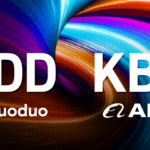
China To Pull The Rest of EM Into The Spotlight
By Anthony Sassine, CFA, Henry Greene, and Robin Zheng
Executive Summary
- In our last commentary, Are we nearing peak volatility for EM and China?, we discussed our belief that nearing peaks in inflation and rates could help reignite risk-taking globally. Since then, commodity prices have begun to cool, and we are seeing a slowdown in the US housing and automotive markets due to higher interest rates.
- As the dust settles, we believe investors will start focusing on fundamentals again, and EM and China will be beneficiaries.
- China outperformed the rest of emerging markets (EM) in the second quarter by a wide margin.1 We believe China’s outperformance should pull the rest of EM into the spotlight.
- Investors can take advantage of opportunities in EM and China through the KraneShares MSCI Emerging Markets ex China Index ETF (Ticker: KEMX), the KraneShares MSCI All China Index ETF (Ticker: KALL), and the KraneShares Emerging Markets Consumer Technology ETF (Ticker: KEMQ).
Introduction
It has been a difficult quarter for global markets. Investors lack a clear view of what is in store for the rest of the year due to persistently high inflation prints in the US, Europe, and many emerging markets (EM). Although we are seeing the light at the end of the tunnel and what appear to be price peaks in energy and materials, many major economies are expected to tighten monetary policy further this summer.
However, China is one of the few exceptions. Inflation in the world’s second-largest economy is under control, and key rates could decline further as China’s central bank attempts to stimulate demand following strict lockdowns and meet its ambitious targets for growth. The near peaks we mentioned in our previous commentary Are We Nearing Peak Volatility in EM & China? seem even closer today.
We are witnessing a potential structural economic regime change, especially in the US and Europe, where rates and valuations are higher, and global growth seems to be challenging, at least in the near term. We believe emerging markets and China should benefit from such changes due to higher growth expectations, lower valuations, and highly bearish positioning. We believe this should help attract long-term investors looking to meet their investment objectives over the next five years.
We typically focus on the KraneShares Emerging Markets Consumer Technology ETF (Ticker: KEMQ) in this EM commentary. In this edition, we would like to spotlight two additional ETFs: the KraneShares MSCI Emerging Markets ex China Index ETF (Ticker: KEMX), which invests broadly in EM countries other than China, and the KraneShares MSCI All China Index ETF (Ticker: KALL), which invests in all China share classes. We believe that China should be its own asset class in an emerging markets allocation, and we developed these two funds to allow investors to right-size their China allocation within a broader EM portfolio. We believe that KALL is the best representation of China because it is agnostic of listing location and represents a fuller China market cap opportunity. Investors can use these two funds to customize their China allocation on their own or, for financial advisors only, follow our Krane Model Portfolio: the Krane Dynamic Emerging Markets Strategy, which dynamically allocates capital between KEMX, KALL, and cash based on widely used fundamental, valuation, and technical signals. Please click here to learn more.
Emerging Markets Q2 Performance Review
Starting with the KraneShares Emerging Markets ex China ETF (KEMX), the fund lost -17.92% during the second quarter of 2022, driven by declines in Korea, Taiwan, and commodity-facing economies such as Brazil and Saudi Arabia. The majority of the decline came in June as KEMX lost -12.60%. KEMX returned -20.79% year-to-date, causing the valuation gap between China and emerging markets (EM) ex China to widen significantly.1 In our opinion, KEMX could be an attractive mean reversion story in the second half of 2022 as risks in key countries dissipate. We believe China’s growing recovery could pull the rest of EM into the spotlight.
For KEMX current standard performance, please click here. Please see below for standard performance disclosure.
The KraneShares MSCI China All Shares ETF (KALL) and China, in general, have carved a very different path this year compared to most global asset classes. The KALL ETF gained +2.79% during the second quarter of 2022 compared to double-digit negative performance for the S&P 500 Index, the MSCI Europe Index, and the MSCI Emerging Markets ex China Index.1 The performance was driven by a general comeback, especially for consumer discretionary stocks, which gained +15.47% in Q2 of 2022, as measured by the MSCI Consumer Discretionary Index, and China A Shares, which gained +9.55% in June of 2022, as measured by the MSCI China A Index.1 Furthermore, clean technology companies in China continued to perform well and enjoy strong policy support. On the other hand, real estate, which is still reeling from regulations and lockdowns, and health care underperformed. The healthcare sector continued to lag as investors digest short-term setbacks for Chinese biotechnology companies on both the international and domestic fronts. For more information, please read our latest commentary on China health care Outlook Healthier For Key Chinese Sector.
For KALL current standard performance, please click here. Please see below for standard performance disclosure.

The KraneShares Emerging Markets Consumer Technology ETF (KEMQ), which was composed of 40% China and 60% EM ex China as of June 30, 2022, experienced both worlds in the second quarter. KEMQ provides exposure to some of the most exciting consumer technology companies in emerging markets including E-Commerce, advertising, gaming, health tech, fintech, and more. While China’s consumer technology stocks made a comeback during the second quarter, consumer technology stocks in other EM countries were not as fortunate. Exposures in South Korea, India, Brazil, and more all saw significant declines during the second quarter of 2022. Negative consumer sentiment in Korea and Taiwan weighed heavily on leading companies such as Naver and KaoKao in Korea and Momo.com in Taiwan. However, we believe this is a short-term underperformance driven by COVID-related events and stubborn inflation rather than the companies' fundamentals. We believe that as Q2 earnings are announced, and investors’ concerns over China regulations, inflation, and COVID continue to ease, emerging markets consumer technology companies stand to benefit, especially at their current low valuations relative to the US and China.
For KEMQ current standard performance, please click here. Please see below for standard performance disclosure.
The performance data quoted represents past performance. Past performance does not guarantee future results. The investment return and principal value of an investment will fluctuate such that an investor’s shares, when sold or redeemed, may be worth more or less than their original cost, and current performance may be lower or higher than the performance quoted. For performance data current to the last month-end, please visit our website at www.kraneshares.com or call +1 (855) 8KRANE8.

Emerging Markets ex China Performance Review
EM performance suffered during the second half of 2022, with only China in the green. Korea was among the hardest hit countries in Asia from an equity performance perspective. The MSCI Korea Index declined -20.83% during the second quarter as unrelenting inflation, higher rates, an omicron wave, China lockdowns, and a truckers’ strike combined to hit consumer confidence and investors’ sentiment severely in June.1 The Bank of Korea revised Q1 GDP from 3% to 2.6% in June on softer growth than initially thought in the exports and manufacturing sectors.1 A similar situation unfolded in Taiwan as inflation, lockdowns in China, and a local COVID-19 wave hit consumer sentiment, leading to a decline of -19.81% for the MSCI Taiwan Index in Q2. Commodity-facing economies such as Brazil, Indonesia, and Saudi Arabia retreated in June as oil and metals prices cooled.
India continues to fare better than most EM countries, helped by strong exports and manufacturing growth. However, the impact of high oil prices was reflected in the country’s balance sheet, which showed a record current account deficit as a percentage of GDP in June.1

EM vs. China - Valuation
China’s outperformance in the second quarter is also reflected well by its equity valuations compared to the US market. While broad EM is still significantly cheaper than the US market compared to its long-term average relative valuation, China’s relative valuation has dipped below its 6-year average, as seen in the chart below, but remains at an over 30% discount to US equities, as measured by the S&P 500 Index.


EM Sector Performance Review
On a sector level, consumer discretionary was the only sector with positive returns during Q2. The MSCI EM Consumer Discretionary Index gained +6.26% in Q2. The sector’s strength was driven entirely by the comeback of China’s consumer discretionary sector, represented by the MSCI China Consumer Discretionary Index, which returned +18% in Q2. Energy was the second-best performer in emerging markets as the MSCI EM Energy Index fell -5.90% during Q2 and -8.51% in June. Information technology and materials were the worst performers as lockdowns impacted Taiwan and Korea semiconductor stocks, disrupting supply chains across Asia.

Outlook
In our last commentary, Are we nearing peak volatility for EM and China? we discussed our belief that nearing peaks in inflation and rates could help reignite risk-taking globally. Since then, commodity prices have begun to cool. Furthermore, due to higher rates, signs of a slowdown in the US housing and automotive markets are materializing. The US 10-year rate has retreated from a peak of 3.5% on June 14th to a trough of 2.8% on July 5th.1 As the dust settles, we believe investors will start to focus on fundamentals again, and EM and China will be beneficiaries. We are starting to see investors position themselves for the future rather than react to the present.
As for the rest of the emerging markets, negative consumer and investor sentiments may be bottoming, especially in Korea and Taiwan. We expect economic activity to pick up as China reopens completely and inflation eases. We still expect both Korea and Taiwan to tighten in the near term. We believe the decline in commodity prices should be a relief and help tame inflation. Signs of a slowdown in India's export and manufacturing sectors, both of which have been a bright spot this year, are emerging. However, the decline in oil prices and inflation should help revive consumer growth, India’s foremost long-term growth driver.
We believe China’s growth should recover in the second half of the year from the impact of the lockdowns. While revenue growth for Chinese companies may come below the long-term trend, we believe earnings growth will remain robust as companies continue to cut costs and bad investments. We believe low valuations, low positioning, and the end of the regulatory cycle in China will continue to attract investors as growth recovers. COVID-19 outbreaks remain the main risk for China. With the elections nearing, we believe China may have to relax its COVID-19 policy significantly, especially if it proves to be a continued impediment to meeting the government’s growth targets. In June, the central government released new guidelines for disease prevention intended to reduce the economic toll of any future lockdowns. For more on this, please read our latest China Internet Earnings Report.
We believe investors have turned positive on China’s A-shares after a year and a half hiatus. China’s mainland market is home to some of China’s most lucrative and innovative sectors, including food and beverage, home appliances, healthcare, cleantech, 5G, high-end manufacturing, and more. In addition to its long-term growth potential as China transitions to the new economy, the A-shares market is opening up. It could potentially receive significant flows from foreign and domestic investors. In June, the government proposed a draft law to allow pension funds to invest in the market. Also, as China continues to confirm that “housing is for living, not for speculation,” we expect flows to be redirected to Mainland stocks. The long-term story for China and emerging markets has not changed but was rather interrupted by the pandemic, war, and regulations, among other issues. We believe the unwinding of some or all of these issues could be a near-term catalyst for emerging markets, as it was for China in the second quarter.
Citations:
- Data from Bloomberg as of 7/5/2022.
- Data from Bloomberg, Morningstar, Archer, and KraneShares as of 6/30/2022.
- Tang, Frank. "China GDP: 2022 economic growth target is within reach, 'but it will come at a cost,'" South China Morning Post. March 11, 2022.
Definitions:
MSCI China All Shares Index: The MSCI China All Shares Index captures large and mid-cap representation across China A‐shares, B‐shares, H‐shares, Red‐chips, P‐ chips, and foreign listings (e.g. ADRs). The index aims to reflect the opportunity set of China share classes listed in Hong Kong, Shanghai, Shenzhen, and outside of China. It is based on the concept of the integrated MSCI China equity universe with China A-shares included. The index was launched on June 26, 2014.
MSCI Emerging Markets (EM) Index: The MSCI Emerging Markets Index is a free-float weighted equity index that captures large and mid-cap representation across Emerging Market (EM) countries. The index covers approximately 85% of each country's free-float adjusted market capitalization. The index was launched on January 1, 2001.
FTSE Emerging Index: The FTSE Emerging Index provides investors with a comprehensive means of measuring the performance of the most liquid large- and mid-cap companies in the emerging markets. The index is derived from the FTSE Global Equity Index Series (GEIS), which covers 99% of the world’s investable market capitalization. The series includes large and mid-cap securities from advanced and secondary emerging markets, classified in accordance with FTSE Russell's transparent Country Classification Review Process. The index was launched on June 30, 2000.
S&P 500 Index: The S&P 500 Index is widely regarded as the best single gauge of large-cap U.S. equities. There is over USD 9.9 trillion indexed or benchmarked to the index, with indexed assets comprising approximately USD 3.4 trillion of this total. The index includes 500 leading companies and covers approximately 80% of available market capitalization. The index was launched on March 4, 1957.
MSCI EAFE Index (“EAFE”): The MSCI EAFE Index is an equity index, which captures large and mid-cap representation across Australia, Austria, Belgium, Denmark, Finland, France, Germany, Hong Kong, Ireland, Israel, Italy, Japan, the Netherlands, New Zealand, Norway, Portugal, Singapore, Spain, Sweden, Switzerland, and the UK. With 825 constituents, the index covers approximately 85% of each country's free float-adjusted market capitalization. The index was launched on March 31, 1986.
Total Social Financing (TSF): Total social financing is a broad measure of economic credit and liquidity as it includes off-balance sheet forms of financing such as initial public offerings, loans from trust companies, and bond sales.
Forward Price to Earnings (P/E): The forward price to earnings ratio is a version of the ratio of price to earnings, which is expressed as earnings per share (EPS) divided by the price per share, that uses forecasted earnings for the P/E calculation.
Earnings per Share (EPS): Earnings per share is calculated as a company's profit divided by the outstanding shares of its common stock.
MSCI Korea Index (referred to as Korea herein): Inception Date: March 31, 1989. The MSCI Korea Index is designed to measure the performance of the large and mid-cap segments of the South Korean market. The index covers about 85% of the Korean equity universe.
MSCI Taiwan Index (referred to as Taiwan herein): Inception Date: July 31, 1989. The MSCI Taiwan Index is designed to measure the performance of the large and mid-cap segments of the Taiwan market. The index covers about 85% of Taiwan's free float-adjusted market capitalization.
MSCI India Index (referred to as India herein): Inception Date: April 30, 1993. The MSCI India Index is designed to measure the performance of the large and mid-cap segments of the Indian market. The index covers approximately 85% of the Indian equity universe.
MSCI Brazil Index (referred to as Brazil herein): Inception Date: January 01, 2001. The MSCI Brazil Index is designed to measure the performance of the large and mid-cap segments of the Brazilian market. The index covers about 85% of the Brazilian equity universe.
MSCI Saudi Arabia Index: The MSCI Saudi Arabia Index is designed to measure the performance of the large and mid-cap segments of the Saudi Arabia market. The index incorporates foreign ownership limit restrictions. With 37 constituents, the index covers approximately 85% of the free-float adjusted market capitalization in Saudi Arabia. The index was launched on October 3, 2014.
MSCI Turkey Index: The MSCI Turkey Index is designed to measure the performance of the large and mid-cap segments of the Turkish market. With 12 constituents, the index covers about 85% of the equity universe in Turkey. The index was launched on January 31, 1990.
MSCI Indonesia Index: The MSCI Indonesia Index is designed to measure the performance of the large and mid-cap segments of the Indonesian market. With 25 constituents, the index covers about 85% of the Indonesian equity universe. The index was launched on May 31, 1990.
MSCI Emerging Markets Information Technology Net Total Return USD Index: The MSCI Emerging Markets Information Technology Net Total Return USD Index is a free-float weighted equity index. The parent is the MSCI Emerging Markets Index.
MSCI EM Utilities Sector Index: The EM Utilities Sector Index is a free-float weighted equity index. It was developed with a base value of 100 as of December 31, 1998. The parent index is the MSCI Emerging Markets Index.
MSCI EM Industrials Index: The MSCI EM Industrials Index is a free-float weighted equity index. It was developed with a base value of 100 as of December 1, 1998. The parent index is the MSCI Emerging Markets Index.
MSCI EM Energy Sector Index: The MSCI EM Energy Sector Index is a free-float weighted equity index. It was developed with a base value of 100 as of December 31, 1998. The parent index is the MSCI Emerging Markets Index.
MSCI Emerging Markets Communication Services Net Total Return USD Index: The MSCI Emerging Markets Communication Services Net Total Return USD Index is a free-float weighted equity index. The parent index is the MSCI Emerging Markets Index. It is a GICS level 1 Index.
MSCI EM Materials Industry Group Index: The MSCI EM Materials Industry Group Index is a free-float weighted equity index with a base value of 100 as of December 31, 1998. The parent index is the MSCI Emerging Markets Index.
MSCI Emerging Markets Consumer Discretionary Net Total Return USD Index: The MSCI Emerging Markets Consumer Discretionary Net Total Return USD Index is a free-float weighted equity index. The parent index is the MSCI Emerging Markets Index.
MSCI EM Financials Index: THe MSCI Emerging Markets Financials Index captures large and mid-cap representation across 24 EM countries. All securities in the index are classified in the financials sector as per the Global Industry Classification Standard (GICS).
MSCI EM Consumer Staples Index: The MSCI Emerging Markets Consumer Staples Index captures large and mid-cap representation across 24 emerging markets countries. All securities in the index are classified in the Consumer Staples sector as per the Global Industry Classification Standard (GICS).
MSCI EM Health Care index: The MSCI Emerging Markets Health Care Index is designed to capture the large and mid-cap segments across 24 EM countries around the world. All securities in the index are classified in the Health Care sector as per the Global Industry Classification Standard (GICS).
MSCI China Consumer Discretionary Index: The MSCI China Consumer Discretionary Index captures large and mid-cap representation across China H shares, B shares, Red chips, and P chips. Currently, the index also includes Large Cap A and Mis Cap A shares represented at 20% of their free float-adjusted market capitalization. All securities in the index are classified in the Consumer Discretionary sector as per the Global Industry Classification Standard (GICS).
MSCI Europe Index: The MSCI Europe Index captures large and mid-cap representation across 15 Developed Markets (DM) countries in Europe. With 428 constituents, the index covers approximately 85% of the free float-adjusted market capitalization across the European Developed Markets equity universe. The index was launched on March 31, 1986.
Krane Model Portfolio: Krane Model Portfolios are hypothetical models for illustrative purposes only to demonstrate how certain ETFs, including KraneShares ETFs, can potentially fit into an investor’s portfolio. The model portfolios do not represent personalized investment advice or an investment recommendation by KraneShares. Using an asset allocation strategy does not guarantee a profit or protection against loss, and diversification does not eliminate the risk of experiencing investment losses. Index performance and volatility are materially different from that of any model portfolio. There is no assurance that investing in accordance with a model portfolio’s allocations will provide positive performance over any period.
I_KS

















